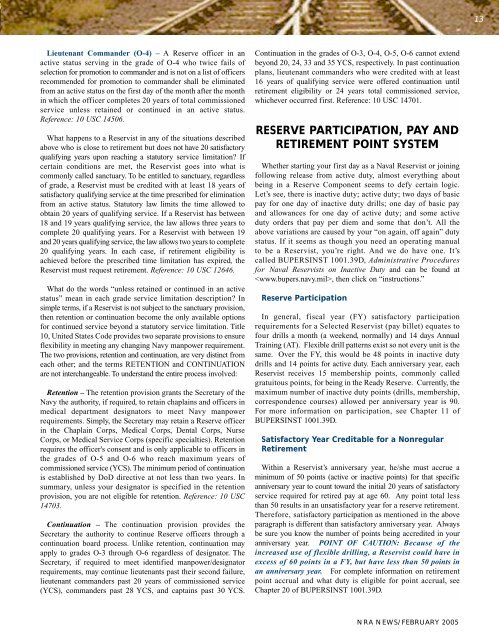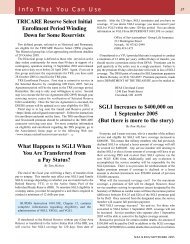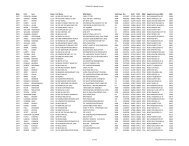Information Track for New Naval Reservists
Information Track for New Naval Reservists
Information Track for New Naval Reservists
- No tags were found...
Create successful ePaper yourself
Turn your PDF publications into a flip-book with our unique Google optimized e-Paper software.
13Lieutenant Commander (O-4) – A Reserve officer in anactive status serving in the grade of O-4 who twice fails ofselection <strong>for</strong> promotion to commander and is not on a list of officersrecommended <strong>for</strong> promotion to commander shall be eliminatedfrom an active status on the first day of the month after the monthin which the officer completes 20 years of total commissionedservice unless retained or continued in an active status.Reference: 10 USC 14506.What happens to a Reservist in any of the situations describedabove who is close to retirement but does not have 20 satisfactoryqualifying years upon reaching a statutory service limitation? Ifcertain conditions are met, the Reservist goes into what iscommonly called sanctuary. To be entitled to sanctuary, regardlessof grade, a Reservist must be credited with at least 18 years ofsatisfactory qualifying service at the time prescribed <strong>for</strong> eliminationfrom an active status. Statutory law limits the time allowed toobtain 20 years of qualifying service. If a Reservist has between18 and 19 years qualifying service, the law allows three years tocomplete 20 qualifying years. For a Reservist with between 19and 20 years qualifying service, the law allows two years to complete20 qualifying years. In each case, if retirement eligibility isachieved be<strong>for</strong>e the prescribed time limitation has expired, theReservist must request retirement. Reference: 10 USC 12646.What do the words “unless retained or continued in an activestatus” mean in each grade service limitation description? Insimple terms, if a Reservist is not subject to the sanctuary provision,then retention or continuation become the only available options<strong>for</strong> continued service beyond a statutory service limitation. Title10, United States Code provides two separate provisions to ensureflexibility in meeting any changing Navy manpower requirement.The two provisions, retention and continuation, are very distinct fromeach other; and the terms RETENTION and CONTINUATIONare not interchangeable. To understand the entire process involved:Retention – The retention provision grants the Secretary of theNavy the authority, if required, to retain chaplains and officers inmedical department designators to meet Navy manpowerrequirements. Simply, the Secretary may retain a Reserve officerin the Chaplain Corps, Medical Corps, Dental Corps, NurseCorps, or Medical Service Corps (specific specialties). Retentionrequires the officer's consent and is only applicable to officers inthe grades of O-5 and O-6 who reach maximum years ofcommissioned service (YCS). The minimum period of continuationis established by DoD directive at not less than two years. Insummary, unless your designator is specified in the retentionprovision, you are not eligible <strong>for</strong> retention. Reference: 10 USC14703.Continuation – The continuation provision provides theSecretary the authority to continue Reserve officers through acontinuation board process. Unlike retention, continuation mayapply to grades O-3 through O-6 regardless of designator. TheSecretary, if required to meet identified manpower/designatorrequirements, may continue lieutenants past their second failure,lieutenant commanders past 20 years of commissioned service(YCS), commanders past 28 YCS, and captains past 30 YCS.Continuation in the grades of O-3, O-4, O-5, O-6 cannot extendbeyond 20, 24, 33 and 35 YCS, respectively. In past continuationplans, lieutenant commanders who were credited with at least16 years of qualifying service were offered continuation untilretirement eligibility or 24 years total commissioned service,whichever occurred first. Reference: 10 USC 14701.RESERVE PARTICIPATION, PAY ANDRETIREMENT POINT SYSTEMWhether starting your first day as a <strong>Naval</strong> Reservist or joiningfollowing release from active duty, almost everything aboutbeing in a Reserve Component seems to defy certain logic.Let’s see, there is inactive duty; active duty; two days of basicpay <strong>for</strong> one day of inactive duty drills; one day of basic payand allowances <strong>for</strong> one day of active duty; and some activeduty orders that pay per diem and some that don’t. All theabove variations are caused by your “on again, off again” dutystatus. If it seems as though you need an operating manualto be a Reservist, you’re right. And we do have one. It’scalled BUPERSINST 1001.39D, Administrative Procedures<strong>for</strong> <strong>Naval</strong> <strong>Reservists</strong> on Inactive Duty and can be found at, then click on “instructions.”Reserve ParticipationIn general, fiscal year (FY) satisfactory participationrequirements <strong>for</strong> a Selected Reservist (pay billet) equates tofour drills a month (a weekend, normally) and 14 days AnnualTraining (AT). Flexible drill patterns exist so not every unit is thesame. Over the FY, this would be 48 points in inactive dutydrills and 14 points <strong>for</strong> active duty. Each anniversary year, eachReservist receives 15 membership points, commonly calledgratuitous points, <strong>for</strong> being in the Ready Reserve. Currently, themaximum number of inactive duty points (drills, membership,correspondence courses) allowed per anniversary year is 90.For more in<strong>for</strong>mation on participation, see Chapter 11 ofBUPERSINST 1001.39D.Satisfactory Year Creditable <strong>for</strong> a NonregularRetirementWithin a Reservist’s anniversary year, he/she must accrue aminimum of 50 points (active or inactive points) <strong>for</strong> that specificanniversary year to count toward the initial 20 years of satisfactoryservice required <strong>for</strong> retired pay at age 60. Any point total lessthan 50 results in an unsatisfactory year <strong>for</strong> a reserve retirement.There<strong>for</strong>e, satisfactory participation as mentioned in the aboveparagraph is different than satisfactory anniversary year. Alwaysbe sure you know the number of points being accredited in youranniversary year. POINT OF CAUTION: Because of theincreased use of flexible drilling, a Reservist could have inexcess of 60 points in a FY, but have less than 50 points inan anniversary year. For complete in<strong>for</strong>mation on retirementpoint accrual and what duty is eligible <strong>for</strong> point accrual, seeChapter 20 of BUPERSINST 1001.39D.NRA NEWS/FEBRUARY 2005
















